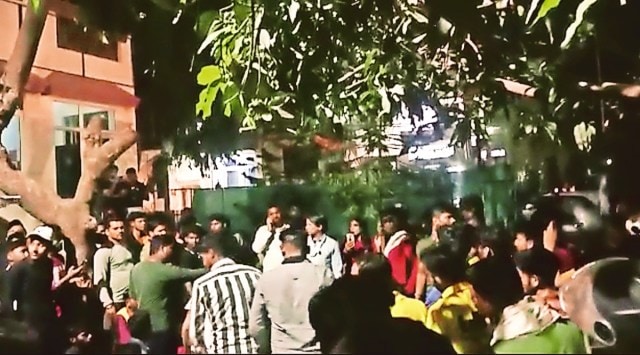“Blinkit betrayed us, but WhatsApp really helped,” quipped a 26-year-old man, working at the Zomato-owned quick commerce firm Blinkit. He is among the thousands protesting against a new payout policy which these workers say would halve their monthly income and make their jobs unsustainable. The protests are now in their fifth day, and even with hundreds of stores shut down due to a shortage of workers and others working on a fraction of their capacity, Blinkit is unlikely to roll back the change.

Some fifty odd workers at multiple locations that The Indian Express spoke to said that after experiencing the new payout structure, they realised that it will slash their daily income by 40-50 per cent.
Story continues below this ad
“It is not like we just saw the change and started our protest. We delivered orders as usual under the new pay structure to see if we make similar, if not more, money for one day. For about 12 hours of work per day, we could earn around Rs 1,200 – but under the new structure, that came down to Rs 600-Rs 700,” a worker said.
With that data in hand, it was time to agitate against the company. Workers created several WhatsApp groups to coordinate protests across hundreds of Blinkit’s inventory stores and project larger numbers at each one of them. One such group titled “Halla Bol” that this paper saw had thousands of workers from across Delhi, Gurugram and Noida where workers were sharing a number of things important for the protests to continue.
“Once we had the fresh figures, we all formed a WhatsApp group – which now has more than 1,000 workers – and decided that striking was the only way to get the company’s attention,” a second worker, also one of the admins of Halla Bol said. “If not for these groups, we would not have been able to sustain the strikes for so many days. We share timings of when to strike, which stores to strike at, and also any media coverage that the protests are getting.”
New flashpoint
These fresh protests mark a new flashpoint in the rising conflict between workers and the firms, after years of brimming discontent. As companies and lawmakers have romanticised the concept of firms offering “gig” work to people becoming an attractive avenue for employment, workers at these firms have been, for long, silently fighting many battles.
Story continues below this ad
With an uncertain income, a low base pay, algorithms that they say pushes them to ride for hundreds of kilometres a day in return for disproportionately low cash, compounded by rising fuel costs, post-pandemic jitters, no social security benefits, and a faceless management, the money left in their hand at the end of each month is on a steady decline.
Over the years, workers from firms like Zomato, Swiggy, Ola, Uber, and Urban Company have gone on strike after overnight changes in their pay structures were imposed on them, often without any kind of intimation, let alone consultation.
While the conflict is expected to rage on beyond Blinkit, actions of workers have, in the past, been met with heavy handed measures from the companies. In the case of Urban Company, for instance, in 2021 it had sued hundreds of women that were protesting against a new company policy at the time. The lawsuit practically ended the strike as workers feared criminal prosecution.
While Blinkit is yet to go down that road, it has blocked the accounts of hundreds of workers that are participating in the strike, with a message on their app reading: “Account terminated due to strike enabler (sic)”.
Story continues below this ad
The absence of a formal union, and even the inability to form one has also made it difficult for workers to come together on policy changes. Organising on platforms like WhatsApp is the only way out for them for now.
There are other realities too. Even within these firms’ gig workforce, people have unequal socio-economic privileges – while some can afford to strike for over a week while making no money, many do not have that option. For them, the choice is to either fight for what they feel is their right, or to put food on the table for a family where they are typically the sole breadwinners. That makes it difficult – impossible even – for everyone to come together in unison.
Email queries sent to Blinkit did not elicit a response.
While Blinkit wouldn’t say if the measure is majorly being executed as a cost-cutting exercise – and the firm’s executives would have one believe in off-record conversations over the phone that it is not – three of its store managers in Delhi told this paper that their seniors had told them that the firm was facing a cash crunch, which primarily necessitated the restructuring in the payout structure for its delivery workers.
Story continues below this ad
Deep in red
In its first ever quarterly earnings report in Q3 FY’23, Blinkit posted a loss of more than Rs 288 crore as opposed to a revenue of Rs 300 crore. Blink Commerce’s loss from the time it was acquired by Zomato (August 10, 2022) to December 31 came at Rs 483.4 crore.
And indeed now that it belongs to the stable of a publicly listed company in Zomato, the scrutiny into the quick commerce business has only increased. It has put a clear strain on Zomato’s balance sheet, with the firm saying that its business – “excluding the acquisition of Blinkit” – had turned adjusted EBITDA positive for the month of January.
Off the record, while discussing that the payout change is certain to force a number of workers to quit the platform, the firm also appeared to be far away from the on-ground reality of its delivery workers’ background.
“We don’t anticipate a delivery job to be someone’s aspiration… for us, an ideal delivery worker is perhaps a student looking to make some money to pay for tuition or a model looking to make some money on the side to pay the bills ,” a Blinkit executive told this paper, speaking off the record.
Story continues below this ad
Anyone who has ever as much interacted with a worker from these firms would testify to its workforce not filled with “students” or “struggling models”, but with people who have migrated from small villages to big cities like Delhi, looking to earn a livelihood – delivering orders on motorbikes and cycles braving harsh weather conditions, often putting their lives at risk.
This Indian Express had earlier reported about how in the pursuit of finishing deliveries within 8-10 minutes, quick commerce firms such as Blinkit and Zepto were pushing their delivery workers, threatening to cut their pay, and forcing them to engage in rash driving and make light of traffic rules.
Blinkit also would not say if it did a cost-benefit analysis of how the new payout structure could impact daily and monthly earnings of its workers. In an unlisted YouTube video – created to address concerns being raised by the protesting workers – that a company executive shared with this paper, a person wearing a Blinkit jacket was seen explaining to two other men how he managed to make more than Rs 85 in one particular order.
The person in the video claimed he made Rs 86.62 in an order, after having driven for close to 6 kilometres. While Rs 86 is significantly higher than the Rs 40 that a worker was making per order on an average before the change, there seems to be a catch – the distance driven.
Story continues below this ad
Blinkit’s entire business model and marketing blitz has so far been based on quick 10 minute deliveries. The company has in the past said that to be able to deliver an order that quickly, it was opening more dark stores closer to people’s homes – a key pitch it also used to counter concerns that its drivers were rushing to deliver every order.
“The reality is we will probably never have to drive 6 kilometres to deliver an order,” a worker said. “I work out of the Vasant Kunj store and most of my deliveries happen within a 1-2 kilometre radius. Also, if one has to drive for 6 kilometres to deliver an order, how will that delivery ever be complete in 10 minutes,” he asked.

































